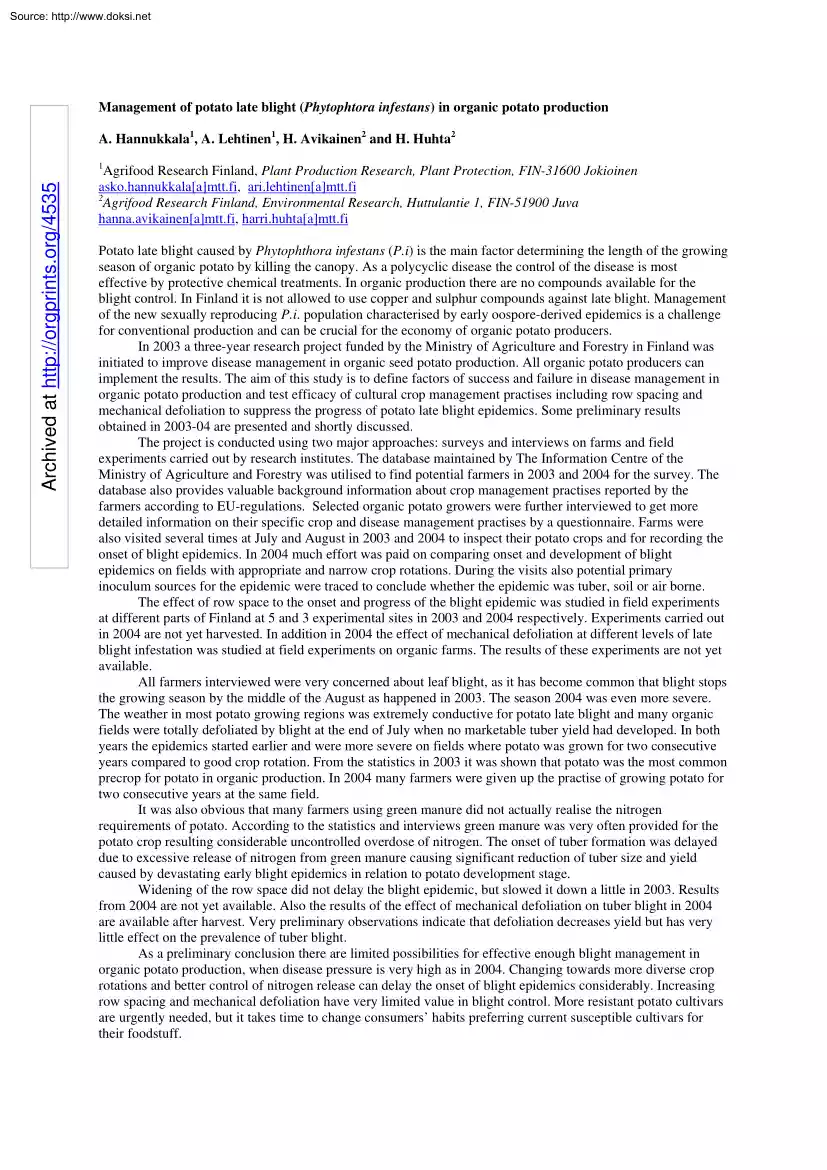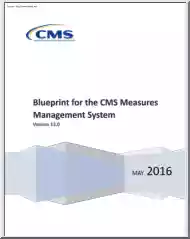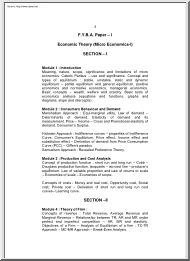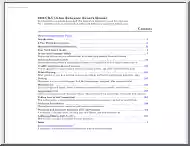Comments
No comments yet. You can be the first!
What did others read after this?
Content extract
Source: http://www.doksinet Management of potato late blight (Phytophtora infestans) in organic potato production A. Hannukkala1, A Lehtinen1, H Avikainen2 and H Huhta2 Archived at http://orgprints.org/4535 1 Agrifood Research Finland, Plant Production Research, Plant Protection, FIN-31600 Jokioinen asko.hannukkala[a]mttfi, arilehtinen[a]mttfi 2 Agrifood Research Finland, Environmental Research, Huttulantie 1, FIN-51900 Juva hanna.avikainen[a]mttfi, harrihuhta[a]mttfi Potato late blight caused by Phytophthora infestans (P.i) is the main factor determining the length of the growing season of organic potato by killing the canopy. As a polycyclic disease the control of the disease is most effective by protective chemical treatments. In organic production there are no compounds available for the blight control. In Finland it is not allowed to use copper and sulphur compounds against late blight Management of the new sexually reproducing P.i population characterised by early
oospore-derived epidemics is a challenge for conventional production and can be crucial for the economy of organic potato producers. In 2003 a three-year research project funded by the Ministry of Agriculture and Forestry in Finland was initiated to improve disease management in organic seed potato production. All organic potato producers can implement the results. The aim of this study is to define factors of success and failure in disease management in organic potato production and test efficacy of cultural crop management practises including row spacing and mechanical defoliation to suppress the progress of potato late blight epidemics. Some preliminary results obtained in 2003-04 are presented and shortly discussed. The project is conducted using two major approaches: surveys and interviews on farms and field experiments carried out by research institutes. The database maintained by The Information Centre of the Ministry of Agriculture and Forestry was utilised to find potential
farmers in 2003 and 2004 for the survey. The database also provides valuable background information about crop management practises reported by the farmers according to EU-regulations. Selected organic potato growers were further interviewed to get more detailed information on their specific crop and disease management practises by a questionnaire. Farms were also visited several times at July and August in 2003 and 2004 to inspect their potato crops and for recording the onset of blight epidemics. In 2004 much effort was paid on comparing onset and development of blight epidemics on fields with appropriate and narrow crop rotations. During the visits also potential primary inoculum sources for the epidemic were traced to conclude whether the epidemic was tuber, soil or air borne. The effect of row space to the onset and progress of the blight epidemic was studied in field experiments at different parts of Finland at 5 and 3 experimental sites in 2003 and 2004 respectively. Experiments
carried out in 2004 are not yet harvested. In addition in 2004 the effect of mechanical defoliation at different levels of late blight infestation was studied at field experiments on organic farms. The results of these experiments are not yet available. All farmers interviewed were very concerned about leaf blight, as it has become common that blight stops the growing season by the middle of the August as happened in 2003. The season 2004 was even more severe The weather in most potato growing regions was extremely conductive for potato late blight and many organic fields were totally defoliated by blight at the end of July when no marketable tuber yield had developed. In both years the epidemics started earlier and were more severe on fields where potato was grown for two consecutive years compared to good crop rotation. From the statistics in 2003 it was shown that potato was the most common precrop for potato in organic production. In 2004 many farmers were given up the practise of
growing potato for two consecutive years at the same field. It was also obvious that many farmers using green manure did not actually realise the nitrogen requirements of potato. According to the statistics and interviews green manure was very often provided for the potato crop resulting considerable uncontrolled overdose of nitrogen. The onset of tuber formation was delayed due to excessive release of nitrogen from green manure causing significant reduction of tuber size and yield caused by devastating early blight epidemics in relation to potato development stage. Widening of the row space did not delay the blight epidemic, but slowed it down a little in 2003. Results from 2004 are not yet available. Also the results of the effect of mechanical defoliation on tuber blight in 2004 are available after harvest. Very preliminary observations indicate that defoliation decreases yield but has very little effect on the prevalence of tuber blight. As a preliminary conclusion there are
limited possibilities for effective enough blight management in organic potato production, when disease pressure is very high as in 2004. Changing towards more diverse crop rotations and better control of nitrogen release can delay the onset of blight epidemics considerably. Increasing row spacing and mechanical defoliation have very limited value in blight control. More resistant potato cultivars are urgently needed, but it takes time to change consumers’ habits preferring current susceptible cultivars for their foodstuff
oospore-derived epidemics is a challenge for conventional production and can be crucial for the economy of organic potato producers. In 2003 a three-year research project funded by the Ministry of Agriculture and Forestry in Finland was initiated to improve disease management in organic seed potato production. All organic potato producers can implement the results. The aim of this study is to define factors of success and failure in disease management in organic potato production and test efficacy of cultural crop management practises including row spacing and mechanical defoliation to suppress the progress of potato late blight epidemics. Some preliminary results obtained in 2003-04 are presented and shortly discussed. The project is conducted using two major approaches: surveys and interviews on farms and field experiments carried out by research institutes. The database maintained by The Information Centre of the Ministry of Agriculture and Forestry was utilised to find potential
farmers in 2003 and 2004 for the survey. The database also provides valuable background information about crop management practises reported by the farmers according to EU-regulations. Selected organic potato growers were further interviewed to get more detailed information on their specific crop and disease management practises by a questionnaire. Farms were also visited several times at July and August in 2003 and 2004 to inspect their potato crops and for recording the onset of blight epidemics. In 2004 much effort was paid on comparing onset and development of blight epidemics on fields with appropriate and narrow crop rotations. During the visits also potential primary inoculum sources for the epidemic were traced to conclude whether the epidemic was tuber, soil or air borne. The effect of row space to the onset and progress of the blight epidemic was studied in field experiments at different parts of Finland at 5 and 3 experimental sites in 2003 and 2004 respectively. Experiments
carried out in 2004 are not yet harvested. In addition in 2004 the effect of mechanical defoliation at different levels of late blight infestation was studied at field experiments on organic farms. The results of these experiments are not yet available. All farmers interviewed were very concerned about leaf blight, as it has become common that blight stops the growing season by the middle of the August as happened in 2003. The season 2004 was even more severe The weather in most potato growing regions was extremely conductive for potato late blight and many organic fields were totally defoliated by blight at the end of July when no marketable tuber yield had developed. In both years the epidemics started earlier and were more severe on fields where potato was grown for two consecutive years compared to good crop rotation. From the statistics in 2003 it was shown that potato was the most common precrop for potato in organic production. In 2004 many farmers were given up the practise of
growing potato for two consecutive years at the same field. It was also obvious that many farmers using green manure did not actually realise the nitrogen requirements of potato. According to the statistics and interviews green manure was very often provided for the potato crop resulting considerable uncontrolled overdose of nitrogen. The onset of tuber formation was delayed due to excessive release of nitrogen from green manure causing significant reduction of tuber size and yield caused by devastating early blight epidemics in relation to potato development stage. Widening of the row space did not delay the blight epidemic, but slowed it down a little in 2003. Results from 2004 are not yet available. Also the results of the effect of mechanical defoliation on tuber blight in 2004 are available after harvest. Very preliminary observations indicate that defoliation decreases yield but has very little effect on the prevalence of tuber blight. As a preliminary conclusion there are
limited possibilities for effective enough blight management in organic potato production, when disease pressure is very high as in 2004. Changing towards more diverse crop rotations and better control of nitrogen release can delay the onset of blight epidemics considerably. Increasing row spacing and mechanical defoliation have very limited value in blight control. More resistant potato cultivars are urgently needed, but it takes time to change consumers’ habits preferring current susceptible cultivars for their foodstuff





